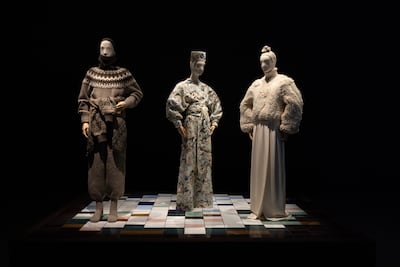If you have a fashion house looking to stage a museum exhibition, your first port of call is probably Judith Clark. The curator, exhibition-maker and professor of fashion and museology at London College of Fashion is a pioneer in the field.
What began as an expression of mid-1990s Cool Britannia-era London experimentation with a non-profit gallery has now evolved into a portfolio of more than 40 exhibitions worldwide. Her latest – If You Know, You Know: Loro Piana’s Quest for Excellence – is Loro Piana’s first exhibition and the Museum of Art Pudong’s first venture into fashion.
Spanning 1,000 square metres across three galleries and 15 rooms, it blends archival documents, heirloom fabrics, artworks from the Sergio and Luisa Loro Piana Collection and the Pinacoteca di Varallo, plus 33 dramatic silhouettes that highlight the connection between raw materials and finished garments. The exhibition is part of a broader centenary celebration for Loro Piana, which also includes a new Assouline book by Nicholas Foulkes.
“They needed quite a lot of reassurance, unsurprisingly,” says Clark about the museum’s initial reaction to the idea of a fashion exhibition. “Their mandate is to bring international museum collections to Shanghai. It’s an ambitious, wonderful mandate. So it was important that it be non-commercial, that it have a strong didactic element. A clear relation to art history, curatorial history. That was very important.”

The exhibition unfolds as an immersive landscape, integrating textures, natural materials and a rich colour palette. Soft carpets, cashfur-lined walls, wood, leather, brass and sanpietrini stone create an environment that reflects Loro Piana’s DNA. Visitors journey through meticulously curated spaces, encountering the brand’s six-generation family legacy, from its roots in Valsesia, Piedmont, to its evolution into understated luxury.
“It gets softer in terms of a sort of absolute experiential feeling,” Clark explains of the journey through the exhibition. “The floors get softer. They go from stone to wood to carpet. Suddenly, the walls get softer, the walls are then padded. So you are made aware of something without actually touching anything for quite a long time within the exhibition.”
Deference to the museum itself is also a key aspect of the exhibition’s design. “You start with museum paintings, historic Italian paintings, then you get into the archive and then you get into the more scientific work,” Clark explains. “By this point, you’ve been told, ‘this is a museum, so look carefully.’ So then when you get to the fibres, you’re also looking at them with those eyes."
Key sections include The Story of Loro Piana, where historic photographs, documents and artworks chart the maison’s journey. A tribute to Loro Piana’s most popular designs follows, displaying enduring pieces such as the Traveller, Roadster, Spagna, Horsey, Icer, Winter Voyager and Defender jackets, Open Walk shoes, as well as the Andre Shirt. A striking mise-en-scene features mannequins dressed in archival coats standing in a pond, a playful nod to the brand’s renowned water-resistant cashmere.

Balancing archival depth with tactile experience was central to Clark’s approach. “One is an introduction to the other. You need to reassure the visitor by saying, ‘this is a historic show. They’re the real documents. It’s a real family. These are the photos',” she explains. “But you don’t need hundreds of those documents to prove that. You need enough to really evoke it.”
Among the standout archival pieces are sample books that are filled with fabric swatches. “You don’t need thousands of them because you imagine there are thousands of them,” Clark says. “Sometimes, one speaks for the many more evocatively, because you imagine that there is this rich archive. So there was real attention to that selection.”
In the Into Fashion section, Loro Piana’s textile innovation takes centre stage. A white-tiled lab simulates the meticulous fibre-quality control process, with magnified images of baby cashmere projected on to screens. The Landscapes room explores the regions where the maison sources its rarest fibres, from China and the Andes to Japan and New Zealand, framed by textile walls that evoke the tactile nature of Loro Piana’s materials.
The ethos of the exhibition embodies a “craftsmanship over showmanship” mindset, in keeping with Loro Piana’s famously discreet identity. But how does one translate discretion into a large scale exhibition?
“There’s an essential dilemma: How do you exhibit discreetness?” Clark asks. “But actually, there’s something about the exhibition that I ideally hope I’ve achieved. In the curation of it, it’s not showmanship. Every single nail in the cabinet is there for a reason. Every crafted detail of the exhibition has been considered. It’s saying, ‘let’s show it, but let’s show it in our way'.”

One of the biggest challenges of fashion exhibitions is avoiding overt commercialism. Clark has been addressing this concern throughout her career. “Of course, we’re not naive. This is about luxury. But I think we need to kind of be able to hold our nerve and look at these things for what they are. A lot of museums are full of luxury items,” she says, referring to the kind of historic regal adornments we’re all accustomed to and that are found in institutions worldwide. “But into these items goes a lot of cultural history, a lot of craft and a lot of savoir-faire.” That is her magic, to interpret the contemporary with the care we normally interpret the historical.
The exhibition also highlights artistic craftsmanship through intricate silhouettes, including a hand-fringed cashmere skirt and a sculptural linen ensemble. “I think that when you perform those crafts differently,” she says of the silhouettes, “it does make the visitor stop and wonder how something is made, how it looks so light, how it looks so warm, how it looks so soft. It really is noticeable.”
The experience culminates in Restaging Valsesia, an immersive film installation that celebrates the brand’s Piedmontese roots. Visitors are invited to get comfortable and recline on a cashmere-upholstered Cini Boeri sofa and take in a harmonious soundscape that fuses Italian and Chinese influences.
As our conversation concludes, I ask Clark what she has seen change most in fashion exhibitions since her early experimental days in the 1990s. “It’s absolutely the visitor,” she answers without hesitation. “I think the visitor needs to be respected more because they can take on board very complex ideas around dress. Because we identify with dress, we know it, we wear it, we get the joke. These exhibitions can be more and more complex.”
Her belief that fashion exhibitions can be intellectually engaging and multifaceted aligns perfectly with Loro Piana’s centenary celebration. The storied Italian maison has always embraced complexity and has found its ideal partner in Clark and this landmark exhibition.
If You Know, You Know: Loro Piana’s Quest for Excellence is on at Shanghai’s Museum of Art Pudong until May 5




